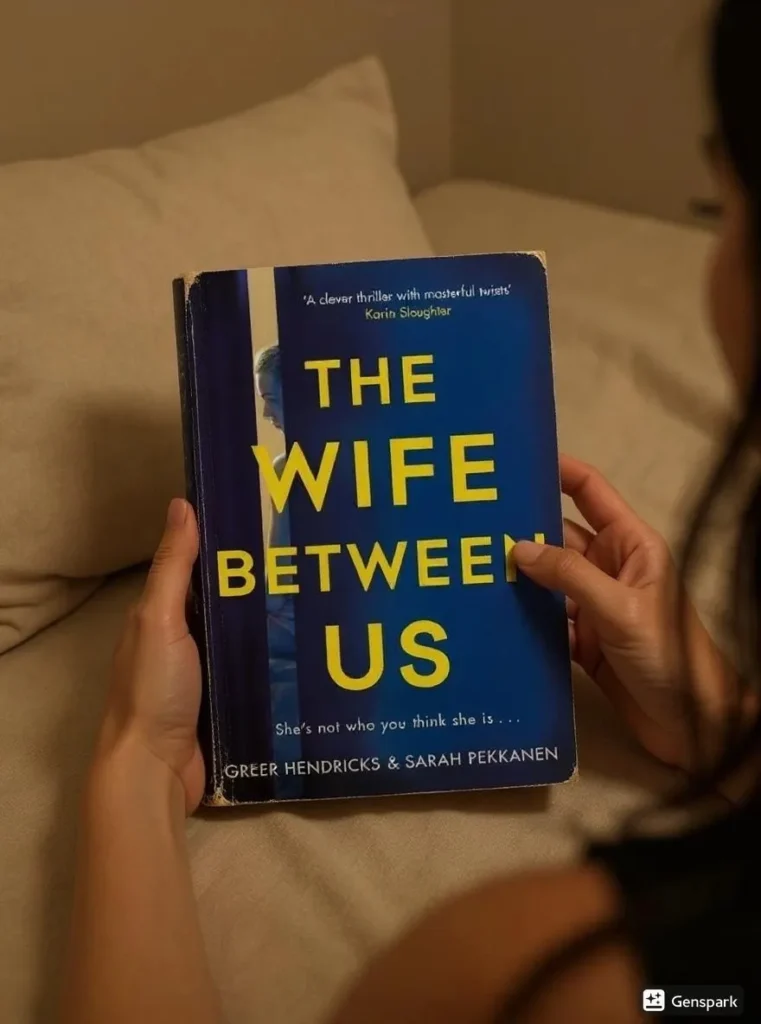I grabbed The Wife Between Us on a Friday night in October, coffee getting cold as rain drummed against my apartment windows. I expected another predictable ex-wife-stalks-new-girlfriend story. Instead, I found myself texting my brother at 2:47 AM: “You need to read this book NOW.”
What started as casual weekend reading became an obsession. I read until my eyes burned, skipped Saturday brunch plans, and called in sick Monday because I couldn’t stop thinking about the final revelations. This psychological thriller destroyed every assumption I’d made about divorce, manipulation, and who deserves our sympathy.
The book follows Vanessa, recently divorced and working retail after her marriage to wealthy Richard ended. She watches Richard’s young fiancée Emma with what appears to be dangerous obsession. But nothing here is what it seems. By page 200, I realized I’d been completely wrong about most of the thing.
I’ve read hundreds of domestic thrillers, but none left me feeling this shaken. Greer Hendricks & Sarah Pekkanen’s craft a story that exposes how we judge women, how abuse operates in plain sight, and how our assumptions can be deadly wrong in the first place. This isn’t just entertainment—it’s a masterclass in psychological manipulation that mirrors real-world dynamics.
Key Takeaways
Trauma creates unreliable memory patterns – The fragmented storytelling reflects how abuse survivors process their experiences
Psychological abuse leaves invisible scars – Control and manipulation can destroy someone without physical violence
Society blames victims while protecting charming abusers – The book exposes how we enable predatory behavior through our biases
Co-authorship can create stronger voices when writers share similar backgrounds and complementary skills
Effective plot twists serve character development rather than existing purely for shock value
Basic Book Details
Publishing Information: January 9, 2018 by St. Martin’s Press
Genre: Psychological Thriller / Domestic Suspense
Plot: A divorced woman appears to stalk her ex-husband’s new fiancée, but the truth behind her actions reveals a complex web of psychological manipulation and survival
Series Information: Standalone novel
Page Count: 352 pages
Main Characters:
- Vanessa: Former wife working to rebuild her life after escaping psychological abuse
- Richard: Charming investment banker who uses control and manipulation to dominate relationships
- Emma: Young teacher who becomes Richard’s new target, unaware of the danger she faces
Personal Reading Experience
I started this book curled up in my reading chair with chamomile tea, expecting a quick weekend read. The first section made me roll my eyes—another “crazy ex-wife” story seemed predictable. I almost abandoned it at page 50 when Vanessa’s stalking behavior felt too familiar, too cliché.
Then Part Two hit like a freight train. At 1:30 AM, I literally threw the book across my bed when I realized Vanessa and Nellie were the same person. My heart pounded as the real story unfolded. I spent the next two hours pacing my apartment, mind racing through every detail I’d misunderstood.
The revelation that “Nellie” was Richard’s condescending nickname for Vanessa—because she was a “nervous nellie”—made my stomach clench. I’ve known men like Richard, charming controllers who make women feel crazy for noticing red flags. The psychological accuracy hit too close to home.
Narrative Structure And Timeline Mastery
The authors construct this story like a psychological puzzle box. Each chapter reveals new pieces while recontextualizing previous information. I found myself flipping back through earlier sections, seeing how cleverly planted details suddenly made perfect sense.
The timeline manipulation isn’t just clever—it mirrors how trauma affects memory. Vanessa’s fragmented recollections feel authentic to anyone understanding PTSD. The past intrudes on the present in unpredictable waves, just like real traumatic memories.
Part One deliberately activates our prejudices about divorced women. Part Two forces us to confront those assumptions. This structural choice makes readers complicit in the victim-blaming the book critiques.
Character Development And Psychological Depth
Vanessa’s character arc shattered my expectations completely. What initially appeared as unhinged obsession transformed into protective desperation. The authors reveal her true motivations gradually, building empathy while maintaining suspense.
Richard represents every charming manipulator who’s ever made a woman question her own sanity. His evolution from prince charming to psychological predator follows documented abuse patterns. The love-bombing phase, the isolation tactics, the gaslighting—it’s textbook manipulation disguised as romance.
Emma’s youth and naivety reminded me of my own past relationships with older, controlling men. Her excitement about Richard’s attention feels painfully real. The authors capture how easily intelligent women can miss red flags when someone makes them feel special.
Thematic Analysis And Social Commentary
This book dissects domestic abuse with surgical precision. The psychological manipulation tactics Richard employs—financial control, social isolation, emotional undermining—reflect real-world abuse patterns. The authors avoid sensationalizing violence while exposing how destruction happens in plain sight.
The age gap between Richard and Emma adds layers of commentary about power dynamics. His preference for younger women isn’t romantic—it’s predatory. Experience teaches women to recognize manipulation, so he targets those who haven’t learned the warning signs yet.
The novel also critiques how society treats abuse survivors. Vanessa’s post-divorce behavior gets labeled as “crazy ex-wife” syndrome, demonstrating how victim-blaming perpetuates abuse cycles. We’re more comfortable believing women are hysterical than acknowledging charming men can be monsters.
Writing Craft And Co-Authorship Excellence
Hendricks and Pekkanen’s collaborative voice feels completely unified. Their shared journalism background creates a natural rhythm that maintains suspense without sacrificing character development. Neither author’s individual style dominates—they’ve created something genuinely collaborative.
The misdirection techniques work because they exploit common thriller tropes. Readers expect certain patterns, and the authors deliberately activate those expectations before subverting them. This isn’t cheap manipulation—it’s psychological commentary disguised as entertainment.
Their use of pronoun ambiguity and contextual assumptions mirrors how real misunderstandings develop. The technical skill serves the larger thematic purposes perfectly.
Genre Positioning And Comparative Analysis
| Element | The Wife Between Us | Big Little Lies | The Girl with the Dragon Tattoo |
|---|---|---|---|
| Abuse Focus | Psychological manipulation | Domestic violence | Sexual assault |
| Narrative Structure | Timeline misdirection | Multiple perspectives | Linear investigation |
| Social Commentary | Victim-blaming critique | Suburban facade analysis | Institutional corruption |
| Reader Empathy | Trauma-based sympathy | Flawed character relatability | Justice-seeking satisfaction |
Unlike Gone Girl‘s mutual toxicity, this book clearly identifies victim and perpetrator. Unlike The Girl on the Train‘s addiction-impaired narrator, Vanessa’s unreliability stems from trauma rather than substance abuse. These distinctions matter because they affect how readers process the moral implications.
The book elevates domestic thriller conventions by addressing real social issues. It proves commercial fiction can tackle serious topics without sacrificing entertainment value.

Reader Psychology And Twist Effectiveness
The authors understand cognitive biases and exploit them brilliantly. They activate stereotypes about divorce, mental health, and gender roles, then systematically destroy them. This psychological manipulation serves the story’s examination of real-world assumptions.
When readers realize they’ve misjudged Vanessa, the emotional impact creates lasting impression. The guilt of having bought into victim-blaming narratives makes the social commentary more powerful than any lecture could.
Pros
Psychological authenticity elevates thriller elements. The abuse dynamics feel researched and real, not sensationalized for dramatic effect.
Collaborative writing achieves remarkable unity. Two distinct voices blend into something stronger than either could create alone.
Social commentary integrates naturally. The domestic abuse themes serve the story rather than overwhelming it.
Character development surprises without betraying logic. Every revelation feels inevitable in retrospect while remaining shocking in the moment.
Cons
Misdirection may frustrate some readers. The deliberate exploitation of assumptions can feel manipulative rather than illuminating.
Pacing occasionally slows during backstory sections. Some flashback sequences prioritize information over engagement.
Secondary characters lack depth. Supporting players often feel functional rather than fully realized.
The resolution feels somewhat tidy. After exploring complex psychological territory, the ending’s clarity might seem unrealistic.
Final Verdict
The Wife Between Us succeeds as both gripping thriller and important social commentary. The authors use genre conventions to examine serious issues about domestic abuse, victim-blaming, and the dangerous assumptions we make about women’s behavior.
I recommend this book to readers who want their thrillers to mean something beyond entertainment. It’s particularly valuable for anyone seeking to understand psychological abuse dynamics or questioning their own assumptions about relationship conflict.
The collaborative writing demonstrates how shared vision can transcend individual limitations. Hendricks and Pekkanen have created something that challenges readers while delivering satisfying thriller elements.
This book changed how I think about divorce stories, victim narratives, and the subtle ways society enables abusive behavior. It’s stayed with me months after reading, which is the mark of truly effective fiction.
Dionysus Reviews Rating: 7/10
Sip The Unknown—Discover Stories You Never Knew You’d Love!
Dionysus Reviews Has A Book For Every Mood
Biography & Memoir
Fiction
Mystery & Detective
Nonfiction
Philosophy
Psychology
Romance
Science Fiction & Fantasy
Teens & Young Adult
Thriller & Suspense
Frequently Asked Questions
Why Does Richard Target Younger Women Like Emma?
Richard’s preference for younger partners isn’t about attraction—it’s about control. Emma represents someone who hasn’t yet learned to recognize manipulation tactics. Her excitement about his attention and willingness to accommodate his preferences make her an ideal target for his psychological abuse patterns.
The twenty-year age gap gives Richard automatic authority and experience Emma lacks. She interprets his controlling behavior as protectiveness because she hasn’t encountered this type of manipulation before. Older women would recognize the red flags that Emma misses completely.
How Do The Authors Make Vanessa’s Stalking Behavior Seem Justified?
The key revelation that transforms Vanessa from antagonist to protector lies in understanding her true motivations. What appears as obsessive stalking is actually desperate attempts to warn Emma about Richard’s dangerous patterns.
Vanessa’s behavior stems from intimate knowledge of Richard’s escalation tactics. She recognizes the warning signs that preceded her own psychological destruction and feels compelled to prevent Emma from experiencing the same fate. Her methods seem extreme because conventional warnings would be dismissed as jealous ex-wife drama.
What Makes The Vanessa-Nellie Identity Reveal So Effective?
The authors carefully construct separate identities for what readers assume are different people. “Nellie” was Richard’s condescending nickname for Vanessa, highlighting his pattern of diminishing her confidence. This revelation recontextualizes every interaction and assumption readers have made.
The effectiveness lies in how the authors use pronoun ambiguity and contextual clues to maintain the illusion. When the truth emerges, every previous scene gains new meaning. Readers experience the same disorientation that characterizes psychological manipulation.
How Accurately Does The Book Portray Psychological Abuse Tactics?
The psychological manipulation depicted mirrors documented abuse patterns from domestic violence research. Richard’s progression from love-bombing to isolation to control follows recognizable escalation sequences that counselors encounter regularly.
His tactics—controlling finances, undermining friendships, creating dependency—reflect real-world manipulation strategies. The authors avoid sensationalizing physical violence while demonstrating how psychological abuse can be equally destructive. This accuracy gives the thriller elements genuine weight and social relevance.
What Role Does The Co-Authorship Play In The Book’s Success?
Hendricks and Pekkanen’s collaboration benefits from their shared journalism background and complementary experiences. Hendricks’ editorial expertise provides structural discipline while Pekkanen’s established writing success brings narrative confidence.
Their unified voice suggests careful coordination and shared vision. The seamless integration of their individual strengths creates something neither could achieve alone. This collaboration model demonstrates how editorial experience and writing talent can merge into superior storytelling.









